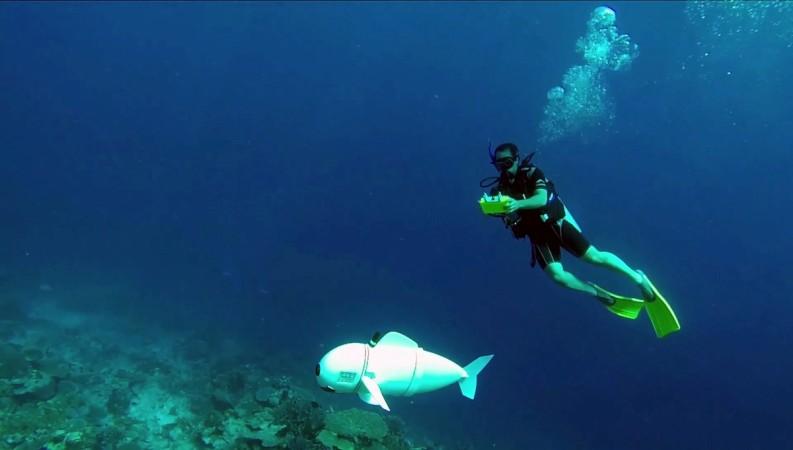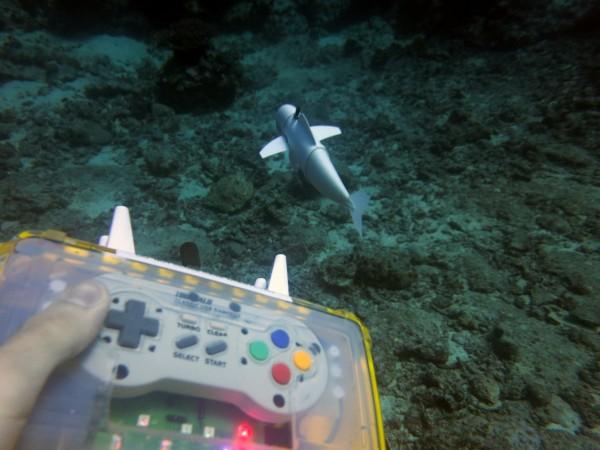
The almost-inaccessible secrets of marine life can now be finally unveiled, thanks to SoFi — a robotic fish built by scientists from the Massachusetts Institute of Technology (MIT) and tested in Fiji.
The fish was reportedly able to swim more than 50 feet below the surface of the water and continued swimming for 40 minutes non-stop.
A study published in Science Robotics says this robotic fish technology could help scientists study organisms that are hard for humans to track.
SoFi — tested in Fiji's Rainbow Reef in 2015 — can not only handle oncoming currents but also take high-resolution photos using a fisheye lens while swimming. An added bonus is the soft robot's ability to swim right next to real fish, which would be beneficial for researchers.
The study said: "Using its undulating tail and a unique ability to control its own buoyancy, SoFi can swim in a straight line, turn or dive up or down. The team also used a waterproofed Super Nintendo controller and developed a custom acoustic communications system that enabled them to change SoFi's speed and have it make specific moves and turns."

MIT scientist Robert Katzschmann said: "To our knowledge, this is the first robotic fish that can swim untethered in three dimensions for extended periods of time. We are excited about the possibility of being able to use a system like this to get closer to marine life than humans can get on their own."
The robotic fish exactly mimics the side-to-side movement of the real ones. "By changing its flow patterns, the hydraulic system enables different tail maneuvers that result in a range of swimming speeds, with an average of about half a body length per second," the study said.
While many of SoFi's components — including the head, which encases all the electronics — were 3D-printed, its back half is made of plastic and silicone rubber.
SoFi's head is also filled with baby oil "since it's a fluid that will not compress from pressure changes during dives," thereby preventing electronic damage, revealed the study.
Biorobotics Professor Cecilia Laschi said: "The authors show a number of technical achievements in fabrications, powering and water resistance that allow the robot to move underwater without a tether. A robot like this can help explore the reef more closely than current robots, both because it can get closer more safely for the reef and because it can be better accepted by the marine species."

Still, the robot's implementation came with challenges, the biggest one being getting SoFi to move at different depths, the researchers said.
The report also said: "To adjust its position vertically, the robot has an adjustable weight compartment and a 'buoyancy control unit' that can change its density by compressing and decompressing air." This is in addition to the two fins that can be used to adjust SoFi's pace in diving up and down.
One of the primary aspects of SoFi's creation was making the robotic fish as minimally disruptive as possible, including keeping its motor as quiet as it could be.
MIT Professor Daniela Rus said: "The robot is capable of close observations and interactions with marine life and appears to not be disturbing the real fish. Collision avoidance often leads to inefficient motion, since the robot has to settle for a collision-free trajectory. A soft robot is not just more likely to survive a collision, but could use it as information to inform a more efficient motion plan next time around."

Researchers are continuing to work on SoFi, with special attention on making it swim quicker and also improving its tail and body designs.
Professor Rus said: "We view SoFi as a first step toward developing almost an underwater observatory of sorts. It has the potential to be a new type of tool for ocean exploration and to open up new avenues for uncovering the mysteries of marine life."















